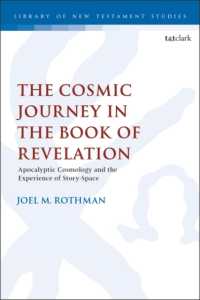- ホーム
- > 洋書
- > 英文書
- > Philosophy
Full Description
This book draws on aesthetic theory, including ideas from the history of painting, music and dance, to offer a fresh perspective on the video game as a popular cultural form. It argues that games like Grand Theft Auto and Elektroplankton are aesthetic objects that appeal to players because they offer an experience of form, as this idea was understood by philosophers like Immanuel Kant and Theodor Adorno.Video games are awkward objects that have defied efforts to categorise them within established academic disciplines and intellectual frameworks. Yet no one can deny their importance in re-configuring contemporary culture and their influence can be seen in contemporary film, television, literature, music, dance and advertising. This book argues that their very awkwardness should form the starting point for a proper analysis of what games are and the reasons for their popularity. This book will appeal to anyone with a serious interest in the increasingly playful character of contemporary capitalist culture. -- .
Contents
AcknowledgementsIntroduction1. The Aesthetic ApproachWhy an aesthetic approach?Play and formForm, taste and societyArt and politicsCulture industry revisited2. Ludology, Space and TimeFrom ergodicity to ludologyGameness and its limitsAbstraction, virtual space and simulacraThe rhythm of suspended timeLudology, narratology and aesthetics3. Controller, Hand, ScreenForm, vision and matterHands and touchThe controllerVideo game imageEmbodied activity and culture4. Games, Dance and GenderDance and artHabitus and embodied playChoreography in 'Mirror's Edge'A dance aesthetic Choreography and discourseAesthetics and gender5. Meaning and Virtual WorldsFictional worldnessNeo-baroque entertainment cultureForm and fictional contentDeath and allegoryPlay and mourning6. Political AestheticsUnit operationsRhetoric and persuasionBadiou's inaestheticsThe ludological truth-eventDancing our way to where?Index -- .







